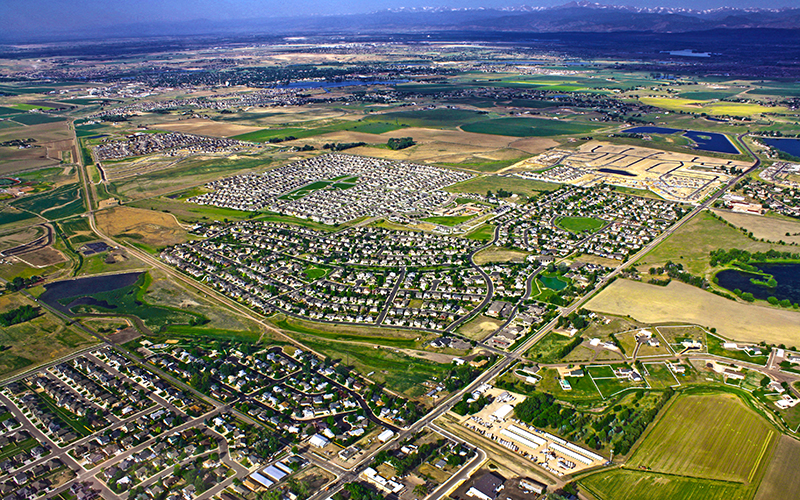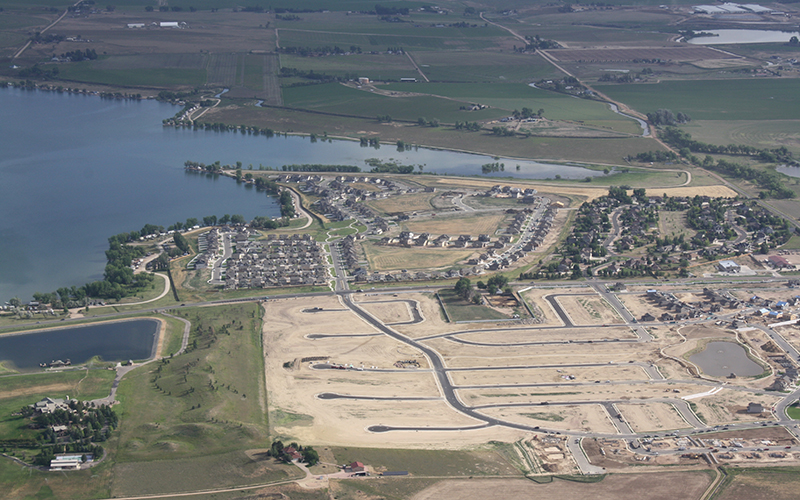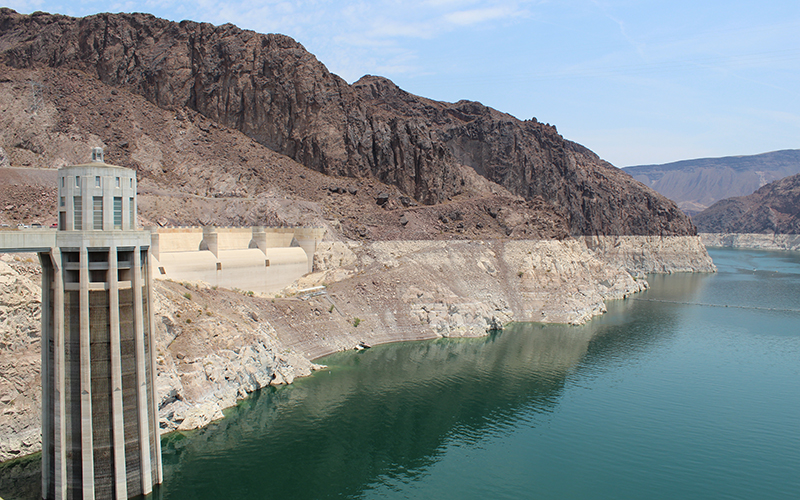
Severance, Colorado, a former farm and ranch town about an hour’s drive north of Denver, is approaching a population of 8,000. Lower housing costs spur many of the newcomers. (Photo by Jodi Petersen/KUNC)
SEVERANCE, Colorado – Birdsong fills the air on a sunny May morning along Severance’s cottonwood-lined main street – but it’s soon drowned out by the roar of a backhoe.
The former farm town is replacing crumbling old water lines that serve a rapidly growing population. Severance, which is about an hour’s drive north of Denver, has seen its population double in the past five years, as home buyers thwarted by soaring prices in larger Front Range cities look for more affordable options.
“(We’re) a very quickly growing community in northern Colorado, I think a really good community, but definitely have seen a lot of growth,” said the town’s community development director, Mitch Nelson.
One of the biggest challenges Severance faces as its population climbs toward 8,000 is securing enough water for continued growth.
That wasn’t something Severance had to worry about just a decade ago. Now, as drought strains much of the state and tens of thousands of newcomers move to the bustling Front Range each year, places like Severance are thinking about growth – and water usage – in ways they never have before.
“In the past, the town’s future goals, from a land use standpoint, weren’t discussed alongside water conservation,” Nelson said. “That was the first step.”
As growing towns compare their existing water supplies to the needs of the new residents and businesses coming their way, they expect they’ll need more water. But figuring out where this new water will come from is the question. Large cities on the Front Range have senior water rights and long-established supplies, whereas small towns like Severance usually don’t.
Severance gets its water from the Northern Weld County Water District, which in turn draws on the Colorado-Big Thompson project. The CBT, as it’s called, delivers water to more than 1 million Front Range residents each year. That water comes from the state’s Western Slope, where snowmelt in the headwaters of the Colorado River is diverted through a tunnel through the Continental Divide.
However, the cost of one unit of CBT water is approaching $65,000, double the cost just a few years ago, thanks to rapidly escalating demand and shrinking supplies due to a 20-year drought. A unit, which is enough to serve two average households in northern Colorado for one year, sold for $1,500 in 1990.
The burgeoning costs mean that towns have a financial incentive to conserve their existing water instead of simply trying to buy more. Lindsay Rogers, the Colorado Basin program manager for the WaterNow Alliance, says the choice is obvious.
“For communities like Severance, the cost per acre foot of conservation is significantly less expensive than new supply,” Rogers said.
The WaterNow Alliance receives funding from the Walton Family Foundation, which also supports KUNC’s Colorado River coverage.

Severance, which lies near a reservoir in Weld County, is integrating water planning into its land use plans – something that wasn’t necessary just a few years ago. (Photo by Jodi Petersen/KUNC)
Conserving water also is cheaper for homeowners; their rates don’t have to be increased to cover expensive new water sources. But conservation alone can’t meet all of a town’s future needs, Nelson said.
“You have to do both,” he said. “You have to acquire the potable water because that is what people use to drink, and reduce the usage of water for irrigation.”
That reduction in irrigation water is mostly going to happen in new developments, as Severance and similar towns work to integrate water planning into their land use planning.
Making growth water-smart from the start provides more bang for the buck.
“When you think about integrating land and water, it’s so that developments are made to be more water efficient from the start,” said Erin Rugland, program manager at Babbitt Center for Land and Water Policy, a nonprofit helping communities in the Colorado River Basin with planning.
For example, new homes can be landscaped with water-thrifty native plants rather than swaths of bluegrass lawns. Those kinds of changes, Rugland noted, are easier and more effective than offering incentives to individual homeowners or businesses to cut water use.
Colorado towns can get help with planning from the state, and through such nonprofits as the Babbitt Center, the WaterNow Alliance and the Sonoran Institute. Severance participated in WaterNow’s training last winter and will get ongoing support from the group’s experts. In January, town officials approved an updated comprehensive plan.
The final plan, which will guide Severance’s land use code, incorporates water conservation throughout and is in line with state objectives for water planning. The plan identifies such opportunities as adopting water-efficient regulations for landscaping, requiring developers to secure their own water supplies for new subdivisions, and working with the Northern Weld County Water District to develop a fee structure that will encourage conservation.
On a wall in Nelson’s office, potential growth areas are highlighted in different colors on a large map.
“The town core is intended to be mixed use housing, higher densities, commercial,” he said. “And then that brown area is where we’ll see the majority of our growth.”
Beyond that brown area, the map shows big light-green swaths of land that will remain rural, Nelson added.
Other small Front Range towns, such as Frederick, Johnstown and Evans, have created similar maps and plans. They’ve implemented water efficiency improvements and passed conservation ordinances. And they’ve bought out farms to use the water rights for more subdivisions.
Nelson said Severance is trying to avoid that.
“I think the goal is to maintain those historic uses and not dry this area up,” he said, “but allow for small scale farming all the way up to the standard agriculture operations we’ve seen historically.”
These Front Range towns will keep growing for the foreseeable future. But planning now for water conservation can take some of the pressure off, allowing towns to not have to compete quite so hard for their slice of a dwindling water supply.
This story is part of ongoing coverage of the Colorado River basin, produced by KUNC, and supported by the Walton Family Foundation. KUNC is solely responsible for its editorial content.
